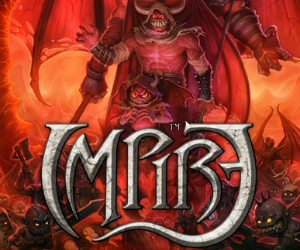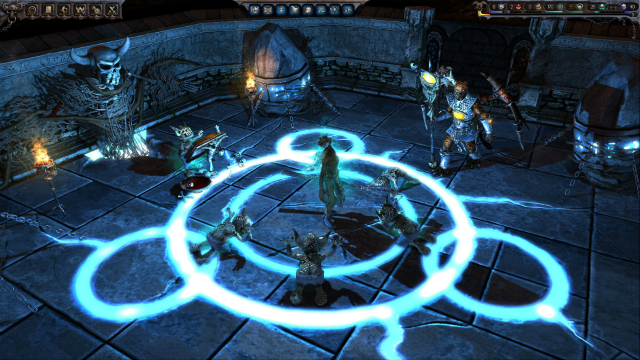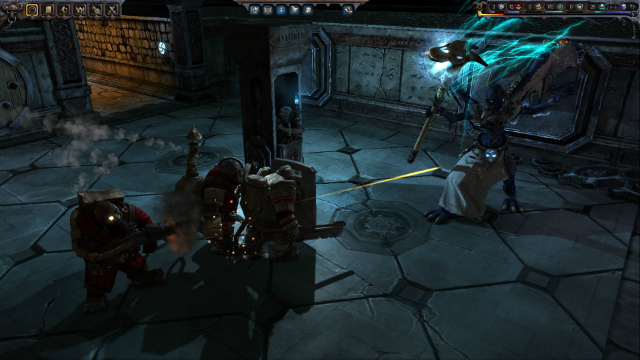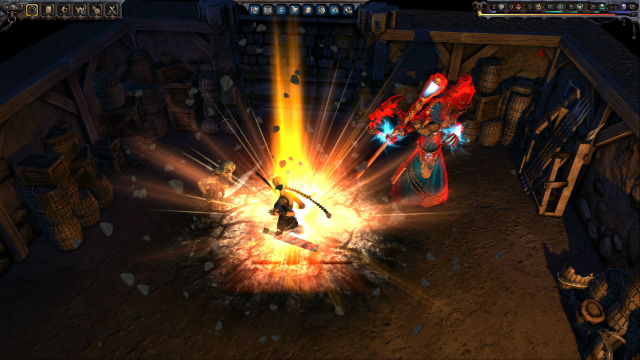 Game: Impire
Game: Impire
Developer: Cyanide Studios
Publisher: Paradox Interactive
Available on: Windows PC Only
It’s been quite a while since I’ve gotten stuck into a decent dungeon-building RTS game, so when the chance to play Impire arose, with it’s dungeon-creation and dark humour, I was excited to get my hands on it. The ability to build a dungeon and kill heroes aren’t all that make this style of game special though; it takes a lot to make a game in the genre really “work” – but have Cyanide Studios managed it? Is Impire more than just a funny-sounding game with an interesting look? Is it actually a decent effort?
STORY: The story in Impire starts as Oscar Van Fairweather is attempting to summon evil help from the depths of the underworld, something that’s he’s tried plenty of times before but has never actually succeeded in doing. This time is different though, and not only is he successful in summoning a demon from beyond, but he manages to summon Báal Abbadon, the leader of the Bottomless Pit. However, things haven’t gone entirely to plan and Báal Abbadon hasn’t come through the process unscathed. Instead of being his usual imposing self, he’s been reduced to nothing more than an imp. That doesn’t mean he’s any nicer though.

It doesn’t matter who he used to be, though. He’s been summoned into this worth to help Oscar Van Fairweather with his evil deeds, and that’s what exactly what he’s going to do, at least to begin with. While you, as Báal Abbadon, will help Oscar with his desire to become something more than a simple, incompetent sorcerer, you’ll eventually break free of his weak spell and start to spread your proverbial (demonic) wings in an attempt to recreate your evil domain within the realm of Ardania.
GRAPHICS: The graphical element of Impire is where it’s let down the most. When the viewpoint is set where it is normally situated, in the standard top-down view of an RTS, the visuals don’t look too bad, but as soon as the camera starts to move down towards the characters you’ll start to see the issues. The most glaringly obvious problem comes into play when you’re looking at one of the many cutscenes: the characters’ mouths don’t move while they’re talking. This is something that you can get by, but having a little bit of movement is something that we’ve gotten used to over the past couple of years and the fact that they don’t move at all in Impire is something that will immediately draw your attention and will no doubt taint your view on the rest of the game.
Thankfully, even with all of the downfalls of the visual element of Impire, a lot of people will forgive it as soon as they start playing the game. Most of your time will be spent looking at the dungeon from a top-down view, a view which minimises how obvious the graphical inadequacies are, and you’ll likely forget that it looks so bad – at least until the next cutscene…
SOUND: Let’s make this clear right off the bat: the music you’ll be listening to while playing the game leaves a lot to be desired. With that out of the way, we can get on to the aspect of the audio design that has been done well – the voice acting. It’s not that the script is delivered particularly well – it isn’t – but the dialogue is genuinely funny all the way through, to the extent that you will find yourself literally laughing out loud at various moments; something you probably won’t be expecting. The dialogue has lots of in-jokes and references, along with plenty of gags (most often directed towards Oscar Van Fairweather from Báal Abbadon himself) that will get you laughing and, more importantly, keep you playing.
Unfortunately, the impressive dialogue is evident only in the game’s numerous cutscenes. Once you’re in the game proper, the intelligent and diverse dialogue will be replaced with repetitive one-liners which, while funny the first couple of times, start to grate after half an hour. For example, you’ll soon be sick of hearing the main character exclaim “I’m walking here!”
GAMEPLAY: The gameplay in Impire centres around concentrating on a single task, given to the player by Oscar at the start of each stage. This could be anything that helps to further his conquest, from killing an opponent to poisoning an entire village or anything in-between. As long as it’s evil, Oscar is interested in doing it. As well as the main mission that you’re attempting to carry out, you’ll be given various optional side quests. These usually require you to collect items from a specific part of the dungeon, or just send a raiding party out to collect some materials from the surface – either way you’ll be rewarded greatly for doing them so it’s in your best interest to at least keep an eye out for them when they do crop up.

When each mission starts you’ll be given one task that you absolutely must complete before you do anything else: create your dungeon. Think of it as the opposite way to how you’ve normally played an MMO or any RPG. In those games you create a hero that has the ability to take on a high level dungeon, taking the loot from inside and slaying the end boss. In Impire, the dungeon is yours, the loot is yours and you are the “end boss”, so you better make sure your dungeon is well-equipped to deal with the hordes of would-be Heroes that will descend upon it. You do this by creating all of the different rooms needed – prisons, kitchens, training rooms, etc – and creating an impish army capable of taking on anything that the fantasy world is prepared to throw at them. The first section of each new mission is purely focused on building your dungeon and levelling it up by added more rooms and collecting more loot, and then creating an army strong enough to keep the Heroes out. Only then is it time to head out and perform raids and complete quests – but be sure to always keep one eye on your dungeon, as you never know when those pesky Heroes could sneak right in.
The raiding system is an integral part of the gameplay too. While killing Heroes and generally playing the game will increase your wealth of both treasure and materials, only by sending out raiding parties into the nearby town are you going to be able to accrue the kind of loot you’ve only ever dreamed about. To do this you need to select your target on the world map, then select the squad that you want to send there. You can then watch your happy minions sack the place and bring the plundered riches back to your dungeon for safe-keeping. The one thing that you need to be aware of while you’re happily sending your underlings to do your bidding, is that if you send all of them out to raid, there’s going to be nobody left to protect your precious dungeon. As all-powerful as Báal Abbadon once was, he’s not quite as impressive or strong in his current Imp form. Perhaps when you’ve completed a few missions, levelled up the dungeon master, and added some increasingly impressive attributes (you get the option to add things to Báal Abbadon, such as large wings and thick skin, once he levels up) you’ll have a chance, but not right at the start, so be careful about just how many raiding parties you’re sending out.
The combat mechanic in Impire, while functional, leaves a lot to be desired. It seems as if even though you may tell your minions to attack a specific target – such as a healer – they will often ignore your direct request and simply attack any enemy in the vicinity of where you clicked. This can get especially annoying when you’ve targetted a specific person for tactical reasons but the game just won’t follow orders. The task will usually get done, sometimes with more casualties than would normally be acceptable, but it’s still a little frustrating to have all that careful planning be effectively for nought.

LONGEVITY: Impire is a game that will last most people a good deal of time if they’re prepared to put the effort in. The single player campaign has the potential to last upwards of 20 hours if you complete all of the side missions that appear in each stage, or if you spend the time needed to upgrade your dungeon until it can pretty run itself. Of course, players could just jump in, do what’s needed and jump back out but they would be missing a lot of content, much of which has been clearly lovingly created. The ability to include friends in missions and take part in multiplayer skirmishes will increase the lifespan of the game for some players, but the enjoyment of these sections depends heavily on whether or not you enjoy the core gameplay mechanics.
VERDICT: There’s no doubt that Impire is a fun game to play, but repetitive gameplay mechanics, a less than stellar story and various issues keep it from being a little more special. Fans of the RTS genre (especially games such as Dungeon Keeper and Overlord) will find something to like here, and the game’s humour has to be applauded as something that will keep people entrenched in the title for more than they would probably be expected to. The fact is, Impire’s problems could be fixed with patches from the developer, but whether the developer actually releases those patches is another thing entirely. We’ll just have to wait and see.






